Indonesian National Armed Forces
The Indonesian National Armed Forces (Indonesian: Tentara Nasional Indonesia, literally "Indonesian National Military"; abbreviated as TNI) are the military forces of the Republic of Indonesia. It consists of the Army (TNI-AD), Navy (TNI-AL), and Air Force (TNI-AU). The President of Indonesia is the commander-in-chief of the Armed Forces. In 2016, it comprises approximately 395,500[7] military personnel including the Indonesian Marine Corps (Korps Marinir), which is a branch of the Navy.
| Indonesian National Armed Forces | |
|---|---|
| Tentara Nasional Indonesia | |
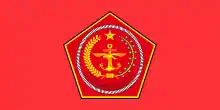 Flag of the Indonesian National Armed Forces | |
 Insignia of the Indonesian National Armed Forces | |
| Motto | Sanskrit: Tri Dharma Eka Karma ("Three services, one determination") |
| Founded | 5 October 1945 as Tentara Keamanan Rakyat (People's Security Forces) |
| Current form | 3 June 1947 as Tentara Nasional Indonesia (Indonesian National Armed Forces) |
| Service branches | |
| Headquarters | Cilangkap, Jakarta |
| Website | tni |
| Leadership | |
| Commander-in-Chief | President Joko Widodo |
| Minister of Defence | LG (ret.) Prabowo Subianto |
| Commander of the Indonesian National Armed Forces | ACM Hadi Tjahjanto |
| Manpower | |
| Military age | 18 |
| Available for military service | 131,000,000, age 15–49 (131,000,000[1]) |
| Fit for military service | 108,000,000, age 15–49 (131,000,000[2]) |
| Reaching military age annually | 4,500,000 (131,000,000[3]) |
| Active personnel | 400,000[4] (ranked 13th) |
| Reserve personnel | 400,000[4] |
| Deployed personnel | 3,544[5] |
| Expenditures | |
| Budget | US$9.35 billion (2020) |
| Percent of GDP | 0.7% (2018)[6] |
| Industry | |
| Domestic suppliers | List
|
| Foreign suppliers | |
| Related articles | |
| History | Military history of Indonesia
List of engagements
United Nations Peacekeeping Indonesian National Revolution Darul Islam (Indonesia) Republic of South Maluku PRRI Permesta Incorporation of West Papua into Indonesia Operation Trikora Indonesia–Malaysia confrontation Indonesian invasion of East Timor Insurgency in Aceh Free Papua Movement 2003–2004 Indonesian offensive in Aceh Operation Tinombala |
| Ranks | Indonesian military ranks |
Initially formed with the name of the People's Security Army (TKR), then later changed to the Republic of Indonesia Army (TRI) before changing again its name to the Indonesian National Armed Forces (TNI) to the present. The Indonesian Armed Forces was formed during the Indonesian National Revolution, when it undertook a guerrilla war along with informal militia. As a result of this, and the need to maintain internal security, the Armed forces including the Army, Navy, and Air Force has been organised along territorial lines, aimed at defeating internal enemies of the state and potential external invaders.[8]
Under the 1945 Constitution, all citizens are legally entitled and obliged to defend the nation. Conscription is provided for by law, yet the Forces have been able to maintain mandated strength levels without resorting to a draft. Most enlisted personnel are recruited in their own home regions and generally train and serve most of their time in units nearby.
The Indonesian armed forces (military) personnel does not include members of law enforcement and paramilitary personnel such as the Indonesian National Police (Polri) consisting of approximately 590,000+ personnel, Mobile Brigade Corps (Brimob) of around 42,000+ armed personnel, the Civil Service Police Unit (Municipal police) or Satpol PP, Indonesian College Students' Regiment or Resimen Mahasiswa (Menwa) which is a collegiate military service consisting 26,000 trained personnel, and civil defence personnel (Linmas or Public Protection Service Corps, which replaced the old Hansip in 2014).
History

Before the formation of the Indonesian Republic, the military authority in the Dutch East Indies was held by the Royal Dutch East Indies Army (KNIL) and naval forces of the Royal Netherlands Navy (KM). Although both the KNIL and KM were not directly responsible for the formation of the future Indonesian armed forces, and mainly took the role of foe during Indonesian National Revolution in 1945 to 1949, the KNIL had also provided military training and infrastructure for some of the future TNI officers and other ranks. There were military training centers, military schools and academies in the Dutch East Indies. Next to Dutch volunteers and European mercenaries, the KNIL also recruited indigenous, especially Ambonese, Kai Islanders, Timorese, and Minahasan people. In 1940, with the Netherlands under German occupation and the Japanese pressing for access to Dutch East Indies oil supplies, the Dutch had opened up the KNIL to large intakes of previously excluded Javanese.[9] Some of the indigenous soldiers that had enjoyed Dutch KNIL military academy education would later become important TNI officers, like for example: Soeharto and Nasution.
Indonesian nationalism and militarism started to gain momentum and support in World War II during the Japanese occupation of Indonesia. To gain support from the Indonesian people in their war against the Western Allied force, Japan started to encourage and back Indonesian nationalistic movements by providing Indonesian youth with military training and weapons. On 3 October 1943, the Japanese military formed the Indonesian volunteer army called PETA (Pembela Tanah Air – Defenders of the Homeland). The Japanese intended PETA to assist their forces oppose a possible invasion by the Allies. The Japanese military training for Indonesian youth originally was meant to rally the local's support for the Japanese Empire, but later it became the significant resource for the Republic of Indonesia during the Indonesian National Revolution in 1945 to 1949. Many of these men who served in PETA, both officers and NCOs alike like Soedirman, formed majority of the personnel that would compose the future armed forces.
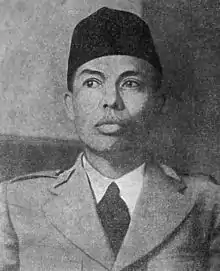
At first, Indonesian Armed Forces started out as the BKR (Badan Keamanan Rakyat – People's Security Agency), which was formed in the 3rd PPKI meeting, on 29 August 1945; this was an organization of militias in a united nationwide force to ensure the security remained intact across the newly declared independent Indonesia; it was created more as a civil defence force than an armed forces. The decision to create a "security agency" and not an army, was taken to lessen the probability of the allied forces viewing it as an armed revolution and invading in full force. During their capitulation, one of the terms of surrender to Japan was to return the Asian domains they had conquered to the previous nation of the Allies, certainly not to liberate them independently.
When confrontations became sharp and hostile between Indonesia and the Allied forces, on 5 October 1945 the TKR (Tentara Keamanan Rakyat – People's Security Armed Forces) was formed on the basis of existing BKR units; this was a move taken to formalize, unite, and organize the splintered pockets of independent troopers (laskar) across Indonesia, ensuing a more professional military approach, to contend with the Netherlands and the Allied force invaders.
The Indonesian armed forces have seen significant action since their establishment in 1945. Their first conflict was the 1945–1949 Indonesian National Revolution, in which the 1945 Battle of Surabaya was especially important as the baptism of fire of the young armed forces.
In January 1946, TKR renamed as the Tentara Keselamatan Rakyat (People's Safety Military Forces), then succeeded by TRI (Tentara Republik Indonesia – Republic of Indonesia Armed Forces), in a further step to professionalize the armed forces and increase its ability to engage systematically.
In June 1947, the TRI, per a government decision, was renamed the TNI (Tentara Nasional Indonesia – Indonesian National Armed Forces) which is a merger between the TRI and the independent paramilitary organizations (laskar) across Indonesia, becoming by 1950 the APRIS or National Military Forces of the Republic of the United States of Indonesia (Angkatan Perang Republik Indonesia Serikat), by mid year the APRI or Military Forces of the Republic of Indonesia (Angkatan Perang Republik Indonesia), absolving also native personnel from within both the former KNIL and KM within the expanded republic.

On 21 June 1962, the name "Tentara Nasional Indonesia" (TNI) was changed to "Angkatan Bersenjata Republik Indonesia" (Republic of Indonesia Armed Forces, ABRI). The POLRI (Indonesian National Police) was integrated under the Armed Forces and changed its name to "Angkatan Kepolisian" (Police Force), and its commander maintained the concurrent status of Minister of Defense and Security, reporting to the President, who is commander in chief. The commanding generals (later chiefs of staff) and the Chief of the National Police then all held ministerial status as members of the cabinet of the republic, while a number of higher-ranking officers were appointed to other cabinet posts. On 1 July 1969, the Police Force's name was reverted to "POLRI".
After the fall of Suharto in 1998, the democratic and civil movement grew against the acute military role and involvements in Indonesian politics. As the result, the post-Soeharto Indonesian military has undergone certain reforms, such as the revocation of the Dwifungsi doctrine and the terminations of military controlled business. The reforms also involved law enforcement in common civil society, which questioned the position of Indonesian police under the military corps umbrella. These reforms led to the separation of the police force from the military. In April 1999, the Indonesian National Police officially regained its independence and now is a separate entity from the armed forces proper. The official name of the Indonesian military also changed from "Angkatan Bersenjata Republik Indonesia" (ABRI) back to "Tentara Nasional Indonesia" (TNI).[10]
Future plans
In the Beginning of 2010, the Indonesian government seeks to strengthen the TNI to achieve minimum standards of minimum strength (Minimum Essential Force). The MEF is divided into three strategic plan stages, 2010–2014, 2015–2019, and 2020–2024. Initially the government budgeted Rp156 trillion for the provision of TNI's main weapon system equipment (alutsista) in the MEF period 2010–2014.[11][12][13]
Naming history
- People's Security Bureau (Badan Keamanan Rakyat, 22 August – 5 October 1945; spelled "Ra'jat")
- People's Security Forces (Tentara Keamanan Rakyat, 5 October 1945 – 7 January 1946; spelled "Ra'jat")
- People's Safety Forces (Tentara Keselamatan Rakyat, 7–26 January 1946; spelled "Ra'jat")
- Republic of Indonesia Armed Forces (Tentara Republik Indonesia, 26 January 1946 – 3 June 1947; spelled "Repoeblik" until 17 March 1947)
- Indonesian National Armed Forces (Tentara Nasional Indonesia, 3 June 1947 – 27 December 1949)
- Republic of the United States of Indonesia War Forces (Angkatan Perang Republik Indonesia Serikat, 27 December 1949 – 17 August 1950)
- Republic of Indonesia War Forces (Angkatan Perang Republik Indonesia, 17 August 1950 – 21 June 1962)
- Republic of Indonesia Armed Forces (Angkatan Bersenjata Republik Indonesia, 21 June 1962 – 1 April 1999; spelled "Bersendjata" until 1 January 1973)
- Indonesian National Armed Forces (Tentara Nasional Indonesia, since 1 April 1999) *the name TNI was still used during ABRI era when it comes to the Military it self and the branches, excluding the Police. e.g. TNI-AD/AL/AU. But when it was Armed Forces as a whole including the Police the term ABRI was used instead.
Philosophy and doctrine
_Indonesia_2013_in_Jakarta%252C_Indonesia%252C_May_24%252C_2013_130524-N-NX489-076.jpg.webp)
The Indonesian military philosophy over-riding defense of the archipelago is summarily civilian-military defence, called "Total People's Defense"- consisting of a three-stage war: a short initial period in which invader would defeat a conventional Indonesian military, a long period of territorial guerrilla war followed by a final stage of expulsion- with military acting as a rallying point for defense from grass-roots village level upwards. The doctrine relies on a close bond between villager and soldier to encourage the support of the entire population and enable the military to manage all war-related resources.
The civilian population would provide logistical support, intelligence, and upkeep with some trained to join the guerrilla struggle. The armed forces regularly engage in large-scale community and rural development. The "Armed Forces Enters the Village" (AMD/TMMD) program, begun in 1983 is held three times annually to organize and assist construction and development of civilian village projects.
The current developments in Indonesia's defense policies are framed within the concept of achieving "Minimum Essential Force" or MEF by 2024. This concept of MEF was first articulated in Presidential Decree No. 7/2008 on General Policy Guidelines on State Defense Policy[lower-alpha 1][14] which came into effect on 26 January 2008. MEF is defined as a capability based defense and force level that can guarantee the attainment of immediate strategic defense interests, where the procurement priority is given to the improvement of minimum defense strength and/or the replacement of outdated main weapon systems/equipment. To achieve this aim, MEF had been restructured into a series of 3 strategic programs with timeframes from 2010 to 2014, 2015 to 2019 and 2020 to 2024 as well as spending of up the 1.5 – 2% of the GDP.
The identity of the Indonesian National Armed forces is (Article 2 of the TNI Law)[15] is the TNI must aim to become the:
- People's Military Forces, the armed forces whose serving personnel come from Indonesian citizens from all walks of life;
- Military of Warriors, which are soldiers who fought to establish the Unitary State of the Republic of Indonesia and do not recognize surrender in carrying out and completing its duties;
- National Armed Forces, the Indonesian national armed forces who serve in the interest of the country and her people over the interests of the regions/provinces, ethnic groups, races, and religions;
- Professional Armed Forces, a military force that is well-trained, well-educated, well-equipped, non-practicable, prohibited to do business and guaranteed welfare, and following the country's political policies that embrace democratic principles, civil supremacy, human rights, the provisions of national law and international laws in force, as ratified and approved in the 1999–2003 amendments to the Constitution.
Organization
The Indonesian armed forces have long been organized around territorial commands.[16] Following independence, seven were established by 1958. No central reserve formation was formed until 1961 (when the 1st Army Corps of the Army General Reserve, "CADUAD", the precursor of today's Kostrad was established). It was only after the attempted coup d'état of 1 October 1965 and General Suharto's rise to the presidency that it became possible to integrate the armed forces and begin to develop a joint operations structure.
Following a decision in 1985, major reorganization separate the Ministry of Defense and Security ("MoDS") from the "ABRI" (Indonesian Armed Forces name during Soeharto's presidential era) headquarters and staff.[17] MoDS was made responsible for planning, acquisition, and management tasks but had no command or control of troop units. The "ABRI" commander in chief retained command and control of all armed forces and continued by tradition to be the senior military officer in the country, while continuing to be a part of the cabinet.
The administrative structure of Ministry of Defense and Security consisted of a minister, deputy minister, secretary general, inspector general, three directorates-general and a number of functional centers and institutes. The minister, deputy minister, inspector general, and three directors general were retired senior military officers; the secretary general (who acted as deputy minister) and most functional center chiefs were, as is the case today, active-duty military officers, while employees and staff were personnel of the armed forces and of the civil service.
The 1985 reorganization also made significant changes in the armed forces chain of command. The four multi-service Regional Defense Commands ("Kowilhans") and the National Strategic Command ("Kostranas") were eliminated from the defense structure, establishing the Military Regional Command ("Kodam"), or area command, as the key organization for strategic, tactical, and territorial operations for all services. The chain of command flowed directly from the "ABRI" commander in chief to the ten "Kodam" commanders, and then to subordinate army territorial commands. The former territorial commands of the air force and navy were eliminated from the structure altogether, with each of those services represented on the "Kodam" staff by a senior liaison officer. The navy and air force territorial commands were replaced by operational commands. The air force formed two Operational Commands ("Ko-Ops") while the navy had its two Fleet Commands, the Western and Eastern Armadas. The air force's National Air Defense Command ("Kohanudnas") remained under the "ABRI" commander in chief. It had an essentially defensive function that included responsibility for the early warning system.
After Suharto's presidential era collapsed in 1998, the Indonesian National Police was separated from the Armed Forces making the Indonesian Armed Forces under the direct auspices command of the Ministry of Defense and the Police Force under the direct auspices of the President of Indonesia. Before 1998, the Armed Forces of Indonesia (the then name "ABRI") was composed of four service branches: Indonesian Army, Indonesian Navy, Indonesian Air Force, and the Indonesian National Police. Then after 1998 (After reformation from Soeharto), the Armed Forces' name, in 1999, was changed to TNI (Tentara Nasional Indonesia) literally meaning: "The National Military of Indonesia" and the independent Indonesian Police Force changed its name to POLRI (Kepolisian Negara Republik Indonesia) literally meaning: "The National Police Force of Indonesia". Now specifically, although the Armed Forces of Indonesia and the National Police of Indonesia has been separated, they still cooperate and conduct special duties and tasks together for the sake of the national security and integrity of Indonesia.
On 13 May 2018, Commander Hadi Tjahjanto reorganized the armed forces once more by inaugurating 4 new military units: Kostrad 3rd Infantry Division, 3rd Fleet Command, 3rd Air Force Operational Command and Marine Force III. The new military units are intended to reduce response time against any threats and problems in Eastern Indonesia. He also officially renamed the Western and Eastern Fleet Commands to 1st and 2nd Fleet Commands.[18]
The Indonesian National Armed Forces is structured into the following in accordance with article 9 of Presidential decree No. 66/ 2019. Indonesian National Armed Forces organization consist of the following:[19]
- General Headquarters, National Armed Forces (Markas Besar TNI. Located at Cilangkap - Jakarta)
- Army Headquarters (Markas Besar TNI AD, located in Army Headquarters, Gambir - Jakarta))
- Navy Headquarters
- Air Force Headquarters
Leadership Elements
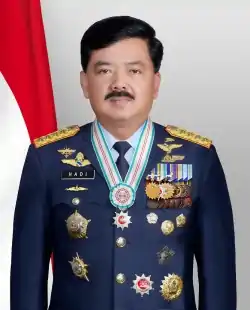
Commander of the Indonesian National Armed Forces (Panglima TNI) and Deputy Commander of Indonesian National Armed Forces serve as the elements of leadership in the Indonesia National Armed Forces, both position are held by the four-star General/Admiral/Air Marshall appointed by and reporting directly to the President of Indonesia, who is overall commander-in-chief of the armed forces. As of Nov 2019, position of deputy commander is still vacant.[20]
Auxiliary Elements of Leadership
- Chief of the General Staff of the TNI (Kasum TNI). Office currently held by: Lieutenant General Ganip Warsito.
- Inspector General of the TNI (Irjen TNI). Office currently held by: Lieutenant General (Marine Corps) Bambang Suswantono.
- TNI Expert Advisor (Korsahli Panglima TNI). Office currently held by: Major General Sisriadi.
- TNI Advisor for Strategic Policy and General Planning (Asrenum Panglima TNI). Office currently held by: Rear Admiral Heru Kusmanto.
- TNI Intelligence Advisor (Asintel Panglima TNI). Office currently held by: Major General Andjar Wiratma.
- TNI Operations Advisor (Asops Panglima TNI). Office currently held by: Major General Tiopan Aritonang.
- TNI Personnel Advisor (Aspers Panglima TNI). Office currently held by: Air Vice Marshal Diyah Yudanardi.
- TNI Logistics Advisor (Aslog Panglima TNI). Office currently held by: Air Vice Marshal Dento Priyono.
- TNI Territorial Advisor (Aster Panglima TNI). Office currently held by: Major General Madsuni.
- TNI Communications and Electronics Advisor (Askomlek Panglima TNI). Office currently held by: Rear Admiral Lutfi Syaefullah.
Service Elements
- Military psychology Center (Pusat Psikologi TNI)
- Communications and Electronics Unit (Satuan Komunikasi dan Elektronika TNI)
- Operational Control Center (Pusat Pengendalian Operasi TNI)
- Bureaucratic Reform Center (Pusat Reformasi Birokrasi TNI)
- Office of the Secretariat General (Sekretariat Umum TNI)
- GHQ Detachment (Detasemen Markas Besar TNI)
Central Executive Agencies
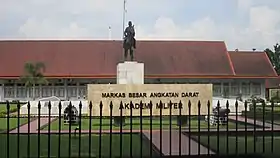

- Staff and Command Colleges (Sekolah Staf dan Komando TNI/ Sesko TNI)
- Army Command and General Staff College
- Naval Command and Staff College
- Air Force Command and Staff College
- Armed Forces Academy (Akademi TNI)
- Military Academy Magelang
- Naval Academy Surabaya
- Air Force Academy Yogyakarta
- Strategic Intelligence Agency (Badan Intelijen Strategis TNI/ Bais TNI)
- Education, Training and Doctrine Development Command (Komando Pembinaan Doktrin dan Latihan TNI/ Kodiklat TNI)
- Special Operations Command (Komando Operasi Khusus/ Koopsus TNI)
- Presidential Security Forces (Pasukan Pengamanan Presiden/ Paspampres)
- Legal Service and General Counsel Agency (Badan Pembinaan Hukum/ Babinkum TNI)
- Public Relations Center (Pusat Penerangan TNI)
- Health Center (Pusat Kesehatan TNI)
- Military Police Center (Pusat Polisi Militer/ Puspom TNI)
- Finance Center (Pusat Keuangan TNI)
- Peacekeeping Maintenance Missions Center (Pusat Misi Pemeliharaan Perdamaian TNI)
- Strategic Assessment and R&D Center ( Pusat Pengkajian Strategis, Penelitian, dan Pengembangan TNI)
- Logistics Agency (Badan Perbekalan/ Babek TNI)
- Chaplaincy Center (Pusat Pembinaan Mental/ Pusbintal TNI)
- Military Historical Center (Pusat Sejarah TNI)
- Information and Communications Technologies and Data Processing Center (Pusat Informasi dan Pengolahan Data/ Pusinfolahta TNI)
- International Cooperation Center (Pusat Kerjasama Internasional TNI)
- Physical Fitness and Military Regulations Center (Pusat Jasmani dan Peraturan Militer Dasar TNI)
- Procurement Center (Pusat Pengadaan TNI)
- Maritime Information Center (Pusat Informasi Maritim)
- General Headquarters Garrison (Komando Garnisun Tetap)
- Cyber Operations Unit (Satuan Siber TNI)
Principal Operational Commands

Principal Operation Commands (Komando Utama Operasi) are the centralized TNI forces which are under the command of Panglima TNI.
| Num | Command | Commander(s) |
|---|---|---|
| 1 | Defense Joint Service Regional Command (Komando Gabungan Wilayah Pertahanan/ Kogabwilhan) | Vice Admiral I Nyoman Gede Ariawan (1st Region); Air Marshal Imran Baidirus (2nd Region); Rear Admiral Arsyad Abdullah (3rd Region) |
| 2 | Army Strategic Command (Komando Strategis Angkatan Darat) | Lieutenant General Eko Margiyono |
| 3 | Fleet Forces Commands (Komando Armada) | Rear Admiral Abdul Rasyid Kacong (1st Fleet); Read Admiral I Nyoman Gede Sudihartawan (2nd Fleet); Read Admiral Dadi Hartanto (3rd Fleet) |
| 4 | National Air Operations Commands (Komando Operasi Udara Nasional) | Air Marshal Tri Bowo Budi Santoso (1st Ops); Air Marshal Minggit Tribowo (2nd Ops); Air Marshal Novyan Samyoga (3rd Ops) |
| 5 | Naval Hydro-Oceanographic Center (Pusat Hidro-Oseanografi) | Rear Admiral Agung Prasetiawan |
| 6 | Regional Military Commands (Komando Daerah Militer) | total 15 regions, each is commanded by two-star army general |
| 7 | Special Forces Command (Komando Pasukan Khusus) | Major General Mohammad Hasan |
| 8 | Military Sealift Command (Komando Lintas Laut Militer) | Rear Admiral Irvansyah |
| 9 | Specialized Forces Corps (Paskhas / Pasgat) | Air Marshal Eris Widodo |
| 10 | Indonesian Marine Corps (Korps Marinir) | Major General (Marine Corps) Suhartono |
Branches
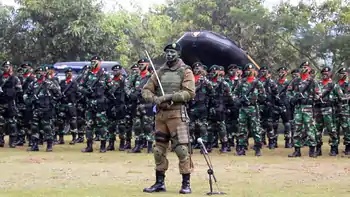
- The TNI-AD (Indonesian Army) was first formed in 1945 following the end of World War II and to protect the newly independent country, it is initially consisted of local militia and grew to become the regular army of today. The force is now capable and has personnel up-to 306,506 and compromises of major and strong territorial army commands known as KODAM and several units, regiments, and battalions all stationed and tasked for the national army defense of Indonesia. The army is also built up of operational commands and special forces such as the: Kopassus and the Kostrad units also with other types of formation within the Army itself. The Army also given the tasks to guard and patrol the land border with Malaysia, Papua New Guinea, and East Timor.

- The TNI-AL (Indonesian Navy) was first formed on 22 August 1945. The current strength of the Navy is around up-to 74,000. In contrast to many other nations and military traditions, the Navy uses Army style ranks (See: Indonesian military ranks).[21] The Navy has three navy fleets which are the 1st Fleet Command (Koarmada I) based in Jakarta, the 2nd Fleet Command (Koarmada II) based in Surabaya and the 3rd Fleet Command (Koarmada III) based in Sorong, all three fleet forces commands holding responsibility for the defense of the three maritime and naval territorial commands. The Navy also has a management of aircraft and aviation systems which are operated by the Naval Aviation Command (Pusat Penerbangan TNI-AL). The Navy operates 52 fixed wing aircraft and 23 combat and transport helicopters.[8] The Navy also includes the Indonesian Marine Corps (Korps Marinir, or KorMar). It was created on 15 November 1945 and has the duties of being the main naval infantry and amphibious warfare force with quick reaction capabilities and special operations abilities.
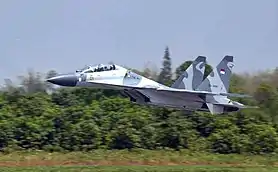
- The TNI-AU (Indonesian Air Force) is headquartered in Jakarta, Indonesia. Its Order of Battle is split into three Air Force Operational Commands (KOOPSAU) (east, central and west regions). Most of its airbases are located on the island of Java.[22] Presently, the Air Force has up-to 34,930 personnel equipped with 202 aircraft including Sukhoi Su-27s, Su-30 fighters, F-16 Fighting Falcon, A-4E Skyhawks, Northrop F-5s, KAI T-50 Golden Eagle.[23] The Air Force also has air force infantry corps which is known as Paskhas that are tasked for airbase defense, airborne troops and special forces unit.
- While no longer a part of the Armed Forces since 1 April 1999, the Indonesian National Police (POLRI) often operate in paramilitary roles independently or in co-operation with the other services on internal security missions usually in cooperation with the Indonesian National Armed Forces (TNI). The National Police Mobile Brigade Corps are the main paramilitary forces which are usually put on to these roles and tasks with the service branches of the armed forces. Until today, both the TNI and the POLRI still holds strong ties and cooperation for the sake of the nation's national security and integrity purposes.
Special Forces Unit
Indonesian Military Special Forces
- TNI AD
 (Indonesian Army): Kopassus
(Indonesian Army): Kopassus - TNI AL
 (Indonesian Navy) & Indonesian Marine Corps : Taifib, Denjaka
(Indonesian Navy) & Indonesian Marine Corps : Taifib, Denjaka - TNI AU
 (Indonesian Air Force): Paskhas
(Indonesian Air Force): Paskhas
In the immediate aftermath of 2018 Surabaya bombings, President Widodo has agreed to revive the TNI Joint Special Operations Command (Koopsusgab) to assist the National Police in antiterrorism operations under certain conditions. This joint force is composed of special forces of the National Armed Forces as mentioned above, and is under the direct control of the Commander of the National Armed Forces.[24] In July 2019, President Widodo officially formed the Armed Forces Special Operations Command (Koopsus TNI) which comprised 400 personnel each from Sat-81 Gultor of Kopassus, Denjaka, and Den Bravo of Paskhas to conduct special operations to protect national interests within or outside Indonesian territory.[25][26]
Budget
Military spending in the national budget was widely estimated 3% of GDP in 2005,[27] but is supplemented by revenue from many military-run businesses and foundations. The defence budget for 2017 was $8.17bn.[28][29]
Beeson and Bellamy wrote in 2002 that: '..By some estimates 60–65% of the military's actual operating expenses come from 'off-budget sources' rather than the government (Cochrane 2002). This is a euphemism for a host of legal and illegal practices that include legitimate involvement in state-owned and private businesses, as well as a range of activities in the 'black economy.' An estimated 30% of government funding of the military 'is lost through corruption in the process of buying military equipment and supplies.'(International Crisis Group 2001: 13)'[30]
In addition, the territorial commands (KODAM) are responsible for 'the bulk of their operational fund-raising.'[31]
| Fiscal Year | Budget (IDR) | Budget (USD) |
|---|---|---|
| 2005 | Rp 21.97 trillion | USD 2.5 billion |
| 2006 | Rp 23.6 trillion | USD 2.6 billion |
| 2007 | Rp 32.6 trillion | USD 3.4 billion |
| 2008 | Rp 36.39 trillion | USD 3.8 billion |
| 2009 | Rp 33.6 trillion | USD 3.3 billion |
| 2010 | Rp 42.3 trillion | USD 4.47 billion |
| 2011 | Rp 47.5 trillion | USD 5.2 billion |
| 2012 | Rp 64.4 trillion[32] | USD 7.5 billion |
| 2013 | Rp 81.8 trillion[33] | USD 8.44 billion |
| 2014 | Rp 83.4 trillion | USD 7.91 billion[34] |
| 2015 | Rp 95.5 trillion[35] | USD 8.05 billion |
| 2016 | Rp 99.5 trillion[36] | USD 7.3 billion |
| 2017 | Rp 109.3 trillion[37] | USD 8.17 billion |
| 2018 | Rp 108. trillion[38] | USD 8. billion |
| 2019 | Rp 121 trillion[39] | USD 9.1 billion |
| 2020 | Rp 131 trillion[39] | USD 9.35 billion |
| *2020 (Budget cuts) | Rp 122 trillion[40] | USD 8.67 billion |
| 2021 | Rp 136 trillion | USD 9.2 billion |
*The 2020 budget was changed due to COVID-19 outbreak, while the budget for the Ministry of Health, and Ministry of Education and Culture has been increased.[40]
Commander
Uniforms
Indonesian armed forces uniforms are categorized into three types:
- PDH: Pakaian Dinas Harian (Service Uniform)
- TNI AD: green shirt, with dark green trousers
- TNI AL: greyish blue shirt, with dark greyish trousers. white shirt with white trousers (for international duties)
- TNI AU: light blue shirt, dark blue trousers
- PDL: Pakaian Dinas Lapangan (Battle / Combat / Field Uniform)
- TNI AD: mostly green cammouflage
- TNI AL: mostly grey cammouflage (except for the marine corps personnel who wear green cammouflage)
- TNI AU: mostly blue camouflage (except for the Pasgat personnel who wear green cammouflage)
- PDU: Pakaian Dinas Upacara (Ceremony / Dress Uniform)
- TNI AD: dark green suit
- TNI AL: white suit. black suit (for international duties).
- TNI AU: light blue coat, dark blue trousers.
Personnel
The Indonesian armed forces are voluntary. The active military strength is 395,500[29] with available manpower fit for military service of males aged between 16 and 49 is 75,000,000, with a further 4,500,000 new suitable for service annually.[27]
Rank structures
In the Indonesian Army, Navy (including Marine Corps), Air Force, and the Police Force, the rank consists of officer known as in Indonesian: "Perwira", NCO: "Bintara" and enlisted: "Tamtama". The rank titles of the Marine Corps are the same as those of the Army, but it still uses the Navy's style insignia (for lower-ranking enlisted men, blue are replacing the red colour).
Armed Forces Pledge (Sapta Marga)
The Armed Forces Pledge is a pledge of loyalty and fidelity of the military personnel to the government and people of Indonesia and to the principles of nationhood.
| Original Indonesian | English |
|---|---|
| 1. Kami Warga Negara Kesatuan Republik Indonesia yang bersendikan Pancasila. | We, solemn citizens of the Republic of Indonesia, truthfully believe in Pancasila. |
| 2. Kami Patriot Indonesia, pendukung serta pembela Ideologi Negara yang bertanggung jawab dan tidak mengenal menyerah. | We, patriots of Indonesia, are the forthright supporter and defender of the nation's ideology and shall admit to refuse surrender. |
| 3. Kami Kesatria Indonesia, yang bertaqwa kepada Tuhan Yang Maha Esa, serta membela kejujuran, kebenaran dan keadilan. | We, humble guardians of Indonesia, who believe in the One True God, are ever-committed to uphold honesty, truth and justice. |
| 4. Kami Prajurit Tentara Nasional Indonesia, adalah Bhayangkari Negara dan Bangsa Indonesia. | We, (the servicemen and women) of the Indonesian National Armed Forces, hereby (swear the oath to forever) serve as the champion of the Indonesian nation and its people. |
| 5. Kami Prajurit Tentara Nasional Indonesia, memegang teguh disiplin, patuh dan taat kepada pimpinan serta menjunjung tinggi sikap dan kehormatan prajurit. | We, (the servicemen and women) of the Indonesian National Armed Forces, strive to uphold military discipline, loyalty to the chain of command and promote the honor and conduct of becoming (military) service personnel. |
| 6. Kami Prajurit Tentara Nasional Indonesia, mengutamakan keperwiraan di dalam melaksanakan tugas, serta senantiasa siap sedia berbakti kepada Negara dan Bangsa. | We, (the servicemen and women) of the Indonesian National Armed Forces, will ever exemplify the values of honor in carrying out our duties, and readily answer to the call of the nation at any time of need. |
| 7. Kami Prajurit Tentara Nasional Indonesia, setia dan menepati janji serta Sumpah Prajurit. | And we, (the servicemen and women) of the Indonesian National Armed Forces, will be faithful, loyal and true to our our Oath of Duty (Enlistment/Commissioning). |
See also
References
- Indonesian: Peraturan Presiden Republik Indonesia No. 7 Tahun 2008 Tentang Kebijakan Umum Pertahanan Negara
- "Indikator Pembangungan Dunia-Penjelajah Google Data Publik". google.co.id. Archived from the original on 20 December 2016. Retrieved 10 December 2016.
- "Indikator Pembangungan Dunia-Penjelajah Google Data Publik". google.co.id. Archived from the original on 20 December 2016. Retrieved 10 December 2016.
- "Indikator Pembangungan Dunia-Penjelajah Google Data Publik". google.co.id. Archived from the original on 20 December 2016. Retrieved 10 December 2016.
- IISS 2018, pp. 266-267
- "Indonesia and the United Nations Peacekeeping Mission". kemlu.go.id. Ministry of Foreign Affairs of the Republic of Indonesia. 29 January 2019. Retrieved 7 January 2020.
- "Military expenditure by country, in constant (2017) US$ m., 1988–2018" (PDF). Stockholm International Peace Research Institute. 2019. Archived (PDF) from the original on 11 July 2019. Retrieved 2 July 2019.
- International Institute for Strategic Studies (3 February 2014). The Military Balance 2014. London: Routledge. pp. 246–250. ISBN 978-1-85743-722-5.
- "Archived copy". Archived from the original on 3 January 2007. Retrieved 12 June 2011.CS1 maint: archived copy as title (link)
- McDonald (1980), pages 13
- Muthiah Alagappa (2001). Coercion and Governance: The Declining Political Role of the Military in Asia. Stanford University Press. pp. 244–. ISBN 978-0-8047-4227-6. Archived from the original on 5 January 2020. Retrieved 28 December 2018.
- "Anggaran Alutsista 2010–2014 Capai Rp156 Triliun". Investor Daily Indonesia. 30 January 2012. Archived from the original on 4 January 2014. Retrieved 4 January 2014.
- "Minimum Essential Force TNI Tahap 2 (2015–2019)". JakartaGreater.com. 11 September 2013. Archived from the original on 4 January 2014. Retrieved 4 January 2014.
- "MEF : Modernisasi Militer Indonesia". analisismiliter.com. Archived from the original on 2 May 2017. Retrieved 27 May 2017.
- "Peraturan Presiden Republik Indonesia Nomor 7 Tahun 2008 Tentang Kebijakan Umum Pertahanan Negara" [Presidential Decree Number 7 Year 2008 on General Policy Guidelines on State Defence Policy]. Presidential decree No. 7 of 2008 (in Indonesian). President of Indonesia. Archived from the original on 19 October 2013. Retrieved 19 October 2013.
- "Undang-undang Republik Indonesia Nomor 34 Tahun 2004 Tentang Tentara Nasional Indonesia" [Law No.34/2004 on Indonesian National Armed Forces]. Article 2, Law No. 34 of 2004 (PDF) (in Indonesian). People's Representative Council. Archived (PDF) from the original on 1 November 2019. Retrieved 12 March 2020.
- Lowry, Bob (1993). Indonesian Defence Policy and the Indonesian Armed Forces, Canberra Papers on Strategy and Defence No.99, Strategic and Defence Studies Centre, Australian National University, 1993, p.36-40
- Library of Congress Country Study, Indonesia, November 1992, Organization and Equipment of the Armed Forces Archived 11 January 2020 at the Wayback Machine
- "Panglima TNI Resmikan Empat Satuan Baru TNI di Sorong". Puspen TNI. 13 May 2018. Archived from the original on 21 May 2018. Retrieved 20 May 2018.
- "Peraturan Presiden Republik Indonesia Nomor 66 Tahun 2019 Tentang Susunan Organisasi Tentara Nasional Indonesia" [Presidential Decree Number 66 Year 2019 Regarding Organization of Indonesian National Armed Forces]. Presidential decree No. 66 of 2019 (PDF) (in Indonesian). President of Indonesia. Archived (PDF) from the original on 19 June 2020. Retrieved 13 May 2020.
- "Jokowi revives deputy commander post for Indonesian Military". Jakata Post. 7 November 2019. Archived from the original on 31 May 2020. Retrieved 13 May 2020.
- Indonesia, PUSPEN TNI, Teamworks. "WEBSITE TENTARA NASIONAL INDONESIA". tni.mil.id. Archived from the original on 3 January 2007. Retrieved 12 June 2011.
- "Scramble Magazine: Indonesian Air Arms Overview". Scramble.nl. Archived from the original on 16 September 2011. Retrieved 25 November 2011.
- "World Air Forces 2019". Flightglobal Insight. 2019. Archived from the original on 23 January 2019. Retrieved 5 July 2019.
- "Jokowi agrees to revive Koopsusgab special forces". Jakarta Post. 18 May 2018. Archived from the original on 18 May 2018. Retrieved 19 May 2018.
- "Dibentuk Jokowi, Ini Tugas Koopssus Gabungan 3 Matra TNI". detik.com. 21 July 2019. Archived from the original on 22 July 2019. Retrieved 22 July 2019.
- "Indonesian Military forms 'super elite unit' to crack down on terrorism". the jakarta post. 30 July 2019. Archived from the original on 2 August 2019. Retrieved 2 August 2019.
- "Archived copy". Archived from the original on 15 October 2015. Retrieved 17 July 2020.CS1 maint: archived copy as title (link)
- "Revised Indonesian budget brings modest increase | Jane's 360". janes.com. Archived from the original on 14 July 2017. Retrieved 14 November 2017.
- The Military Balance 2017. London: International Institute for Strategic Studies. 2017. p. 294.
- Mark Beeson and Alex J. Bellamy, 'Securing Southeast Asia: The politics of security sector reform,' Routledge, 2008, ISBN 0-415-41619-1, 134-5.
- Beeson and Bellamy, 2008, 138.
- "Archived copy". Archived from the original on 5 October 2011. Retrieved 20 August 2011.CS1 maint: archived copy as title (link)
- "While education and healthcare suffer, Indonesian army budget soars". 18 July 2012. Archived from the original on 1 August 2012.CS1 maint: unfit URL (link)
- "Janes | Latest defence and security news". Janes.com. Archived from the original on 4 June 2020. Retrieved 30 June 2020.
- "SBY maintains status quo in 2015 budget". 18 August 2014. Archived from the original on 7 September 2014. Retrieved 7 September 2014.
- "Kementerian PU Dapat Anggaran Terbanyak dari APBN 2016". finansial.bisnis.com. Archived from the original on 6 November 2015. Retrieved 3 November 2015.
- "Revised Indonesian budget brings modest increase – Jane's 360". janes.com. Archived from the original on 14 July 2017. Retrieved 22 July 2017.
- Aziza, Kurnia Sari (26 October 2017). "Kemenhan dan Polri Dapat Anggaran Paling Besar pada APBN 2018". Kompas (in Indonesian). Archived from the original on 11 January 2018. Retrieved 10 January 2018.
- Prasetia, Andhika (5 October 2019). "Jokowi: Anggaran Pertahanan Dinaikkan Lebih Dari Rp 131 Triliun di 2020". detik. Archived from the original on 27 March 2020. Retrieved 27 March 2020.
- Liputan6.com (13 April 2020). "Anggaran Kemhan-KPK Dipangkas untuk Corona, Kemdikbud dan Kemkes Ditambah". liputan6.com (in Indonesian). Retrieved 11 October 2020.
Further reading
| Wikimedia Commons has media related to Military of Indonesia. |
- International Institute for Strategic Studies (14 February 2018). The Military Balance 2018. London: Routledge. ISBN 978-1-85743-955-7.
- Bresnan, John. (1993). Managing Indonesia: the modern political economy. New York: Columbia University Press.
- Many topics, including the political role of the military at the height of Suharto's New Order.
- Chandra, Siddharth and Douglas Kammen. (2002). "Generating Reforms and Reforming Generations: Military Politics in Indonesia's Transition to Democracy." World Politics, Vol. 55, No. 1.
- Crouch, Harold. (1988). The army and politics in Indonesia. Ithaca:Cornell University Press.
- First published 1978. Now somewhat dated, but provides an influential overview of the role of the military in consolidating Suharto's power
- "Guerilla Warfare and the Indonesian Strategic Psyche" Small Wars Journal article by Emmet McElhatton
- Israel, Fauzi.(2009) – Advanced Weapon's Infantry Firepower & Accuracy
- Kammen, Douglas and Siddharth Chandra. (1999). A Tour of Duty: Changing Patterns of Military Politics in Indonesia in the 1990s. Ithaca, New York: Cornell Modern Indonesia Project No. 75.
- Kingsbury, Damen. Power Politics and the Indonesian Military, Routledge: 2003 ISBN 0-415-29729-X
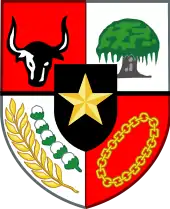
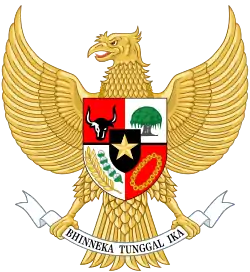
.svg.png.webp)